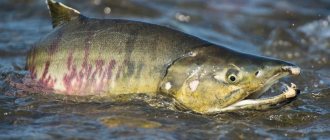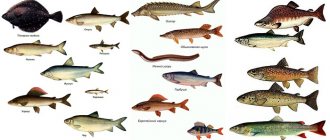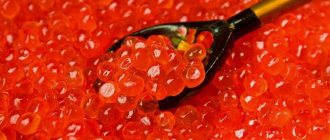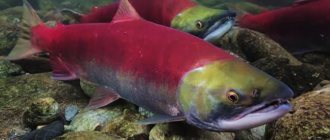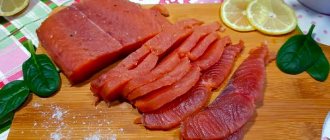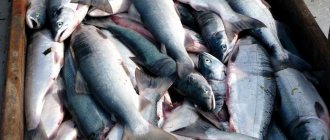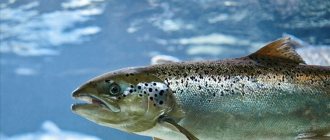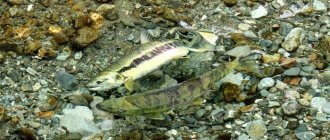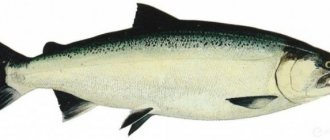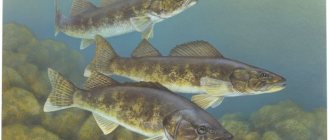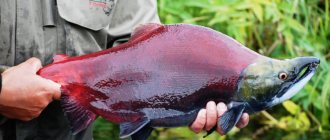general information
Chum salmon
The entire life of chum salmon is divided into two phases. The first lasts until puberty. At this time, the fish lives in the sea, far from the coastal borders. After adult salmon become ready to reproduce, their appearance and lifestyle changes dramatically.
The fish become aggressive, gather in huge schools and migrate en masse to the mouths of rivers where spawning will take place. Chum salmon, unlike most other species of the family, die after laying eggs.
Choosing the right wild fish
If you make a choice between sea and river fish, then the healthiest one is sea fish (mackerel, salmon, herring). It contains a lot of microelements: iodine, zinc, iron, chromium and manganese.
Herring is a good offer
Unlike expensive salmon species, herring will significantly save money. In addition, it surpasses meat in the amount of growth amino acids (methionine, lysine, tryptophan). They have a positive effect on the growth of the body.
The best option would be herring that has not been subjected to heat treatment, that is, lightly salted. Fatty amino acids and valuable proteins are not destroyed.
Is it possible to buy fish by hand?
It’s impossible, because it’s unknown where they were caught. And the most dangerous thing that can happen after consuming an untested product is opisthorchiasis, a disease that affects river fish of the carp family (roach, bream, rudd). It is better to negotiate with fish farms directly and purchase a proven product.
Fish for children and adults
Children up to 3 years old can be given only 30 grams of fish per day. Older children are not recommended to eat fatty fish - salmon, salmon, eel, sturgeon, smoked fish, canned food.
It is recommended to purchase deep-frozen fish. Suitable types:
We buy salmon
- Wild salmon in Russia is more expensive, but also retains more proteins, fats and microelements. If the freezing technology was followed, then commercial salmon is recommended for consumption, but not more often than once a month.
- All red meat fish (coho salmon, pink salmon, chum salmon) living on farms are fed with carotenoids 2 months before slaughter to make the meat brighter.
- If grown in good conditions, it is fed with red pepper and red algae. This fish is very fatty, as it is kept in small tanks.
Recommendations
An indicator of fresh fish is the pink color of the gills. If the scales are cloudy and fall off easily, or do not fit tightly, then the fish is not fresh. Before cooking, do not defrost the fish completely so that the juice does not escape with the liquid.
Press on the body, if the product is fresh, the hole will disappear in 3 seconds. It is better to purchase a carcass rather than a fillet. In production, to obtain fillets, fish are soaked in chemicals to better separate the bones.
Less commonly grown in fish farms are whitefish, sockeye salmon, coho salmon (from salmon), herring, hake, sardine, pollock, and saury. Most often such fish are wild. When preparing, instead of salt, you can use dry seaweed ground in a coffee grinder. The best heat treatment is steaming or boiling in whole pieces. This leaves more trace elements and nutrients.
There is also a way to quickly cook fish. This recipe is a classic heh. Only all seasonings are natural. I use a mixture of 5 peppers and ground garlic. I replace table vinegar with apple cider vinegar, and only unrefined oil.
If you liked the article and the information was useful, then share it with your friends on social networks and subscribe to updates. I look forward to your comments. Prepare delicious and healthy meals and be healthy. Bye!
Appearance
In sea water the fish has a shiny silver color, its body is massive and elongated. During this period, its meat is bright red and dense. By the time it enters the river, a physiological transformation occurs with the fish - a specific “nuptial outfit” appears.
The color changes to yellow-brown with bright purple spots on the sides. The skin becomes thick, the scales become coarser. The body noticeably increases in width, the jaws bend, and large curved teeth grow. By the time of spawning, chum salmon becomes almost black, its meat turns white and loses its nutritional value.
Habitat
Chum salmon can only be found in the Pacific Ocean. It is called anadromous because it lives in the seas and goes to spawn in the freshwater rivers of the Far East, Asia and North America - from the California coast to Alaska itself.
This species of salmon feeds in the North Pacific Ocean, in close proximity to the warm Kuro-Sivo underwater current, which includes seas such as the Sea of Okhotsk, the Bering Sea and the Sea of Japan. Basically, they control the gap of water, up to 10 meters deep from the upper horizon.
With the arrival of spring, it begins to move to the mouths of rivers in the northern regions of America and Canada, the Far East, reaching the Asian coast of South Korea and Japan. Numerous schools of chum salmon enter rivers and streams located in the basin of the Sea of Okhotsk. At the same time, it can also be found in such rivers of Siberia as the Lena, Kolyma, Indigirka and Yana.
After some time, the schools are divided into mature and immature individuals. Those individuals that are not yet ready to spawn return back and head to the southern coasts. Those specimens that are ready to lay eggs are sent to spawning sites, from where they will never return.
Russian experience
Russia has its own trout farms, but they are just developing and cannot replace imported products. In addition, for the most part they rely on the experience of their European colleagues: they invite specialists from Norway, where until recently they purchased food and fry. We do not yet have our own incubators for the production of fry: their creation requires time, technology, and investment. Therefore, it is too early to talk about competition from domestic aquaculture products.
And at this time, Russia remains one of the few countries in whose seas and oceans there are still huge reserves of wild salmon. This is wild Far Eastern salmon, commercially caught in the waters of the Pacific Ocean: pink salmon, sockeye salmon, chum salmon, coho salmon, Chinook salmon and others. In terms of their taste and health benefits, they are head and shoulders above salmon and trout grown in an artificial environment.
Nutrition
Chum salmon eat crustaceans, small mollusks, and, to a lesser extent, small fish (smelt, herring). During the spawning run it does not feed, the digestive organs atrophy. But sometimes chum salmon are caught on hooks by fishermen in rivers when fishing with live bait and when trolling.
This behavior is explained by a genetic reflex - small fish pose a potential danger to eggs, and chum salmon thus “protect” their future offspring. The young feed on insect larvae and the corpses of their parents.
Reproduction
Chum salmon
The life of chum salmon takes place in 2 stages - feeding and spawning. Depending on these stages, the fish lives in the sea or in the river. During feeding, representatives of the species actively feed in a huge water area. Puberty occurs at the age of 3-5 years, less often - at the age of 6-7 years. After the feeding period, chum salmon begins migration to their native rivers, that is, to their places of birth.
Spawning occurs in summer and autumn. In summer, chum salmon spawn in July-September, and in autumn - in September-November. In the fall, representatives of Sakhalin and Amur spawn. In Japan, chum salmon spawn in October-November. Summer chum salmon does not enter rivers as far as autumn ones; for example, in the summer in the Amur it rises upstream a distance of about 700 kilometers, and in the fall it travels 2000 kilometers. Fish spawn twice a year.
In the American Columbia and Yukon rivers, spawning grounds are located at a considerable distance from the mouth, so representatives of the species have to travel 3,000 kilometers upstream. The chum salmon enters the river while still wearing its marine outfit, and then changes it in fresh water. In spawning areas, chum salmon are divided into small groups consisting of several males and one female. For spawning, the optimal water temperature is 1-12 degrees Celsius.
Chum salmon caviar is a delicious delicacy that is also good for health. Females dig small depressions in the sandy bottom where they lay eggs. From above these depressions are filled with sandy soil. The spawning process lasts 3-5 days. One clutch contains about 4 thousand eggs. The female guards the clutch for 8-10 days. After this time, she becomes exhausted and dies. Once spawning, chum salmon live on average for 2 weeks.
There is demand, there will be supply
The problem is that wild salmon stocks are declining dramatically. According to the Food and Agriculture Organization of the United Nations (FAO), 80% of the world's wild fish stocks are either fully exploited or overexploited, requiring immediate intervention by relevant organizations.
In 2015 and 2021, the annual salmon catch averaged from 700 thousand to 1 million tons. Since 2014, many rivers in southern Europe have experienced historically low levels of wild Atlantic salmon returns. And in Alaska and the Pacific Northwest, the numbers of Chinook, king and other salmon species continue to decline.
However, the demand for this fish is still high. To cover it, aquaculture comes into play - farms in which fish are bred in natural and artificial reservoirs or on specially created marine plantations.
Sea fish is a valuable source of Omega-3 unsaturated fatty acids, which are important for our health.
Salmon have been farmed since the 1980s wherever there are cold waters and currents, from Europe's North Sea to New Zealand's Tasman Sea. In 2021, wild salmon accounted for about 1/3 of the total catch, with the remaining 2/3 coming from aquafarmed salmon.
Since salmon farming requires special conditions (proper sea water temperature, correct current, etc.), farmed salmon is produced only off the coast of Great Britain, north-east and north-west USA, Faroe Islands, Ireland, Norway, Chile, New Zealand and Tasmania. Atlantic salmon is also raised in inland waters in special tanks.
Aquaculture is considered an environmentally friendly method of producing protein for humans, but is farmed salmon healthy? There is an assumption that it is farming that is the direct cause of the decline in populations of salmon and other fish in the wild. Since farmed salmon began to be farmed, the numbers of their wild “brothers” have declined sharply. This was mainly due to the spread of diseases and parasites among cultured fish. However, salmon from aqua farms is not only dangerous for its “free” relatives, its benefits to humans are also in great doubt.
Properties
The benefit of chum salmon lies in the presence of numerous substances that are necessary for the body. Fish contains omega-3 and omega-6, as well as lecithin, so it can be considered an excellent anti-atherosclerotic agent. With regular consumption of red fish, you can significantly reduce the risk of myocardial infarction and stroke. Chum salmon contains large quantities of potassium and magnesium - minerals that are important for the normal functioning of the heart muscle. Fish contains calcium and phosphorus, which restore and strengthen bone tissue.
Chum salmon contains thiamine, which has a positive effect on brain function, which in turn improves attentiveness and memory. In addition, this substance is necessary for the normal development of the body and for the functioning of the digestive system, and it also reduces the negative effects of alcohol and tobacco. It is also worth mentioning that chum salmon contains vitamin A, which is important for visual acuity, and it is also involved in the production of collagen. It also contains vitamin E, which acts as an antitoxic agent and has a positive effect on the condition of the skin. Thanks to the presence of ascorbic acid, the immune system is strengthened. Chum salmon contains iron, which improves blood composition and the process of hematopoiesis. Fish helps reduce cholesterol levels in the blood.
Chum salmon can be harmful if you have an individual intolerance to the product. Like any other product, consuming chum salmon in large quantities is not recommended.
The best chum salmon recipes
The following can be noted.
- Fish croquettes. They are incredibly easy to prepare. Fish fillets are combined with white bread soaked in milk. Add eggs, 50 grams of grated cheese, salt and pepper to taste. Minced meat is formed from the prepared mixture, balls are rolled on its basis, which are then rolled in breadcrumbs and fried until tender in a heated deep fat.
- Baked steak. Chum salmon is an ideal option for preparing delicious and healthy dishes. To make a delicious dinner, you will need to take 2 chum salmon steaks, half a lemon, salt, pepper and dill, olive oil to taste. The fish is easily marinated in spices before cooking and baked in foil envelopes in an oven preheated to 180 degrees for no more than 15 minutes. Before serving, sprinkle the fish with lemon juice.
Tasty and healthy chum salmon can become a valuable source of protein and significantly enrich the human diet with nutrients, microelements and amino acids. By choosing the right fish and using proven recipes for its preparation, you can get real culinary masterpieces that will delight people of any age.
And with regular use, chum salmon will help prevent heart and vascular diseases, increase immunity, and protect the body from negative environmental influences.
To learn how to quickly and easily pickle red fish, see the following video.
Chum salmon is widely used in cooking, as it has dietary meat with virtually no small bones. Chum salmon is baked and fried, salted and pickled. Soups and broths for aspic are created on its basis. This fish is added to salads and snacks. But it is important to know how to choose chum salmon in order to purchase a quality product with the maximum range of beneficial properties.
Chum salmon quality standards
If you need frozen chum salmon, GOST 32366-2013 contains information with evaluation criteria for such fish.
- This standard states that spots, darkening and yellowing on the skin of fish are not acceptable.
- Chum salmon should not have mechanical damage or signs of disease.
- The fish has no surface bruising or tissue damage, although the fins may be slightly damaged.
- Frozen chum salmon is evenly covered with a thin ice crust up to several millimeters thick.
For chilled fish, GOST 814-96 applies, which contains a number of other requirements for the quality of the product.
- Chum salmon meat should have a dense consistency.
- The gills are red, pink color is possible.
- The scales are intact and fit tightly to the body.
- Fish without hemorrhages or visible damage.
Selection of chum salmon
Chum salmon is a large fish, the average carcass of which weighs about 5 kg. Its meat is bright pink and its caviar is red. There are several useful tips for consumers to help them understand how to choose frozen chum salmon.
- Chum salmon should have the color and smell characteristic of fresh fish of this type, without any foreign aromas or spots on the body.
- The gills are clean and red. Let's say the gills are pink, this is what they look like when they are cut to drain blood.
- Check the scales for integrity and tightness to the body. The absence of a large number of scales indicates that the product is not fresh and has been moved multiple times from one place to another.
- The body of the chum salmon is elastic and not dried out. When you press on the fish, the hole should quickly disappear.
- There are no tears or peeling in the fish meat.
- When buying frozen chum salmon, carefully inspect the glaze. There should be no sagging or cracks on the ice crust; the ice itself should be transparent or slightly white.
- When buying chum salmon fillets, choose even pieces, since repeated freezing and thawing leads to deformation of such products.
The price of “Fresh frozen chum salmon steak” in Moscow is 269.9 rubles, the price of “Fresh frozen chum salmon steak” is 244.99 rubles. in Moscow, “Favorite chum salmon steak product with skin, glazed frozen” in Moscow can be bought for 501 rubles, the price of “Fresh frozen chum salmon steak” in Moscow is 229.99 rubles.
Chum salmon fishing
The best time for chum fishing is from late August to October. Chum salmon can be caught in its habitat. To spawn, the fish go into shallow rivers. Chum salmon spawn only once, after which it dies. It is better to catch fish before the start of the spawning period or during spawning.
Many fishermen prefer to use a class 9 rod. The fisherman may not feel the beginning of a bite at all, but the fish will break the line and quickly move no less than 40 m downstream. To simplify fishing, you need to have about 100 meters of fishing line on the reel.
Catching chum salmon requires a certain skill and a lot of patience.
All types of salmon are very beneficial for the body. The most common of them are chum salmon and pink salmon. Not every person can distinguish one species from another, but it is not very difficult. Chum salmon are slightly larger and develop bright stripes on their backs during spawning. During spawning periods, male pink salmon develop a hump and their nose lengthens and bends.
